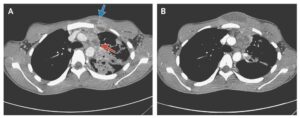This article is an answer to the Case – Migratory, Pruritic Skin Eruption
Physical examination revealed a serpiginous, erythematous raised tract on his right foot, a finding typical of creeping eruption, or cutaneous larva migrans.
The patient was treated with albendazole. After 2 weeks, the lesion healed completely. No recurrence was seen at a 2-month follow-up visit.
Cutaneous larva migrans is most commonly caused by migration, in the skin, of hookworm larvae that are transmitted through contact with feces from infected dogs or cats. The parasite is confined to the epidermis because it lacks the collagenase necessary to break through the basement membrane.
Clinically, it is characterized by an intensely itchy, erythematous, linear or serpiginous eruption that is seen most commonly on the feet, back, buttocks, thighs, or abdomen.
Although it is a self-limited disease, anthelmintic treatment can diminish the symptoms and shorten the duration of disease.

